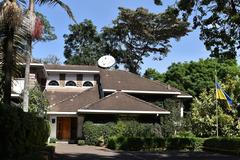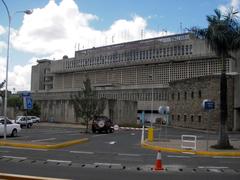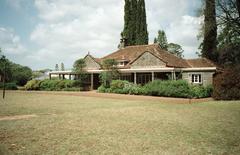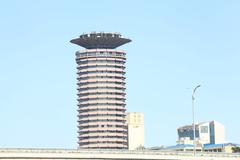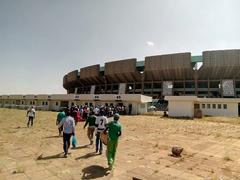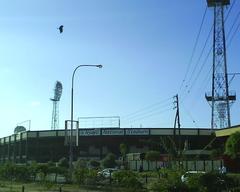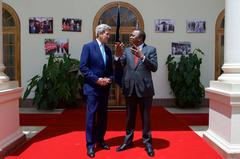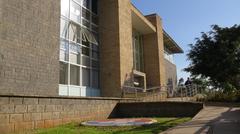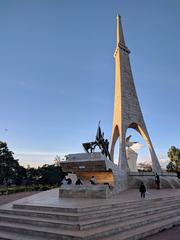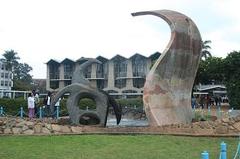Nairobi National Museum: Visiting Hours, Tickets, and Comprehensive Travel Guide
Date: 04/07/2025
Introduction
Nestled on Museum Hill just minutes from Nairobi’s bustling city center, the Nairobi National Museum is Kenya’s premier institution for the celebration and preservation of the nation’s diverse history, culture, art, and natural heritage. Established in 1910, the museum has evolved from a small natural history collection into a vibrant, inclusive hub that chronicles Kenya’s journey from prehistoric times to the present day. Whether you’re a history enthusiast, cultural explorer, family traveler, or simply curious about Kenya, the museum promises an engaging and educational experience.
This guide provides up-to-date information on visiting hours, ticketing, accessibility, highlights of the museum’s extensive collections, special events, and practical travel tips. It also outlines the museum’s historical evolution, significance, and its role in conservation and community engagement. For the latest details and to enrich your visit, consider downloading the Audiala app.
(National Museums of Kenya, African Spice Safaris, Pelago)
Table of Contents
- Introduction
- History and Evolution of Nairobi National Museum
- Institutional Significance and Mission
- Visiting Information
- Exhibitions and Collections
- Special Events and Guided Tours
- Practical Travel Tips
- Photographic Highlights and Etiquette
- Research, Conservation, and Community Impact
- Frequently Asked Questions (FAQ)
- Summary and Final Tips
- References
History and Evolution of Nairobi National Museum
Early Foundations (1910–1930)
The museum’s origins date to 1910, when the East Africa and Uganda Natural History Society began collecting and studying regional flora and fauna. Initial displays were housed in central Nairobi, but growing collections soon necessitated a move. By 1930, the Coryndon Museum opened on its current site, named after Sir Robert Coryndon, then Governor of Kenya.
Colonial Legacy and Growth (1930–1963)
During the colonial era, the museum focused on natural history and paleontology, with significant contributions from scientists like Louis Leakey. While research thrived, local Kenyan narratives and artifacts were often marginalized.
Post-Independence Transformation (1964–2005)
After Kenya gained independence in 1963, the museum was renamed the National Museum of Kenya, reflecting a broader, more inclusive mandate. New galleries and regional museums were developed, and educational outreach expanded.
Modernization and Reclamation (2005–Present)
Extensive renovations in 2005 introduced modern exhibition spaces, accessibility improvements, and innovative storytelling. Exhibits were updated to address colonial legacies and amplify Kenyan voices, with initiatives like “Shujaa Stories” highlighting local heroes and histories.
(African Spice Safaris, National Museums of Kenya)
Institutional Significance and Mission
As the flagship of the National Museums of Kenya (NMK), the museum plays a pivotal role in research, education, and the conservation of Kenya’s tangible and intangible heritage. Under the Museums and Heritage Act of 2006, its mission is to “sustainably manage national heritage through innovative research, knowledge sharing, and entrepreneurship for the benefit of the country and humanity,” aspiring to global leadership in heritage management.
Core objectives include:
- Collection and Preservation: Systematic acquisition and conservation of artifacts, fossils, and works of art.
- Research and Documentation: Facilitating multidisciplinary studies in anthropology, paleontology, ethnography, and more.
- Education and Engagement: Delivering public education through exhibitions, tours, and community programs.
- Sustainable Utilization: Ensuring heritage resources are responsibly managed for future generations.
(NMK Mission and Vision, NairobiPark.org)
Visiting Information
Hours and Ticket Prices
- Opening Hours: Daily from 9:00 AM to 6:00 PM, including weekends and public holidays.
- Ticket Prices:
- Adults (non-residents): KES 700–1200
- Children (under 12): KES 350–600
- Kenyan residents: KES 200–600 (discounted for students and children)
- Combined tickets with the Nairobi Snake Park are available for added value.
Tickets can be purchased at the entrance or online through the National Museums of Kenya website.
Accessibility and Facilities
- Wheelchair Access: Ramps, wide corridors, elevators, and accessible restrooms.
- Visitor Amenities: Café, gift shop, picnic areas, and free Wi-Fi in public zones.
- Guided Tours: Offered daily; booking in advance is recommended, especially for groups or during peak seasons.
- Family-Friendly: Interactive exhibits, play areas, and the adjacent Nairobi Snake Park provide fun for all ages.
(SafariClock, A Family Safari Blog)
Getting There & Nearby Attractions
- Location: Museum Hill Road, about 5 km from Nairobi city center.
- Transport: Easily reached by taxi, ride-hailing apps (Uber, Bolt), or public transport. Ample parking on-site.
- Nearby Attractions: Nairobi Snake Park, Nairobi Gallery, Karen Blixen Museum, David Sheldrick Wildlife Trust.
(Trodly, inthecitymagazine.wordpress.com)
Exhibitions and Collections
Permanent and Rotating Galleries
- Human Origins and Paleontology: Home to world-renowned fossils, including the “Turkana Boy,” and displays on human evolution.
- Archaeology and Prehistory: Stone Age and Iron Age artifacts, tools, pottery, and burial items.
- Ethnography and Cultural Heritage: Artifacts representing Kenya’s over 40 ethnic communities, from Maasai beadwork to Swahili textiles. The Joy Adamson Gallery features historic and contemporary art.
- History and Independence: Exhibits tracing the nation’s political journey, independence movement, and postcolonial era.
- Natural History and Biodiversity: Dioramas and taxidermy of Kenya’s wildlife, geological samples, and interactive environmental displays.
- Contemporary Kenyan Art: Rotating exhibitions of modern works by leading and emerging local artists.
(SafariClock, Pelago, A Family Safari Blog)
Outdoor Attractions
- Botanical Gardens: Over 500 indigenous and 100 exotic plant species, ideal for relaxation and photography.
- Nature Trail: Self-guided trails through native flora and fauna.
- Nairobi Snake Park: A live reptile park featuring indigenous snakes, crocodiles, tortoises, and an aquarium of local fish species.
Iconic Features
- Ahmed the Elephant: The famous life-size mount of Kenya’s legendary tusker.
- Dinosaur Statue: A striking outdoor landmark welcoming visitors.
Special Events and Guided Tours
- Annual NMK Science Expo: Hosted in June, this event features research showcases, workshops, and interactive sessions on heritage conservation and innovation.
- Rotating Exhibitions and Cultural Festivals: Regularly updated, check the museum’s calendar for art shows, lectures, and family activities.
- Guided Tours: Led by experienced curators, these tours offer in-depth insights and are available in multiple languages.
Practical Travel Tips
- Best Visiting Times: Mornings on weekdays are quieter; avoid peak holiday periods for a relaxed experience.
- Transport: Use registered taxis or ride-hailing apps for safety; matatus (shared minibuses) are budget-friendly but require caution.
- Health & Safety: Nairobi is generally safe but remain vigilant with valuables; avoid isolated areas after dark.
- Budgeting: Combined museum/Snake Park tickets offer best value. Credit cards and mobile payments (M-Pesa) are widely accepted.
- Dining: The on-site café offers refreshments, while the gift shop features local crafts and souvenirs.
(SafariClock, A Family Safari Blog)
Photographic Highlights and Etiquette
- Best Photo Spots: Botanical gardens, the dinosaur statue at the entrance, Early Man Gallery, and Ahmed the Elephant display.
- Etiquette: Photography is generally allowed; avoid flash and tripods in sensitive areas, and always respect signage and staff instructions.
- Dress Code: Modest attire is recommended out of respect for cultural exhibits.
Research, Conservation, and Community Impact
The museum is a leading center for scientific research, conservation, and community engagement. Its staff collaborate on projects spanning paleontology, archaeology, biodiversity mapping, and heritage education. Outreach includes volunteer programs, educational workshops, and public events that foster dialogue and innovation.
(NMK, Google Arts & Culture, NMK Science Expo)
Frequently Asked Questions (FAQ)
Q: What are the Nairobi National Museum’s visiting hours?
A: Daily from 9:00 AM to 6:00 PM, including weekends and public holidays.
Q: How much are tickets?
A: Adults (non-residents) KES 700–1200; residents and students enjoy discounted rates.
Q: Are guided tours available?
A: Yes, daily tours are available and can be booked on-site or online.
Q: Is the museum wheelchair accessible?
A: Yes, with ramps, elevators, and accessible restrooms.
Q: Can I take photographs inside?
A: Photography is permitted in most areas, but flash and tripods may be restricted.
Q: Are there family-friendly activities?
A: Absolutely. The museum features interactive exhibits and the Nairobi Snake Park is a favorite with children.
Summary and Final Tips
The Nairobi National Museum stands as a dynamic testament to Kenya’s heritage, offering well-curated galleries, engaging exhibitions, and family-friendly facilities. Its commitment to education, conservation, and inclusivity ensures a rewarding visit for all. For the best experience:
- Purchase tickets in advance, especially during peak seasons.
- Take a guided tour for deeper insight.
- Bring your camera for the gardens and iconic displays.
- Download the Audiala app for audio guides and exclusive content.
- Explore nearby attractions to enrich your Nairobi itinerary.
Your journey through Kenya’s past, present, and future begins here.
(National Museums of Kenya, Google Arts & Culture, SafariClock)
References
- National Museums of Kenya
- African Spice Safaris
- SafariClock
- National Museums of Kenya: Practical Guide
- Pelago
- NairobiPark.org
- Google Arts & Culture
- In The City Magazine
- A Family Safari Blog
- Trodly
